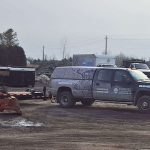Negotiate a better deal by knowing the signs and causes of foundation problems
You’re tired of apartment living. Tired of hearing your neighbour’s dog bark. Tired of paying your landlord’s mortgage.
You’re pre-approved for a mortgage and have cobbled enough money for a downpayment.
You’ve decided to buy a house for the first time. Something to call home. Excited but nervous, you browse listings, start to dream.
As a first-time home buyer, you’ve made a checklist: Decent neighbourhood, maybe a small yard to garden, a garage to park your car. Your list grows. Open floor plan. Tiled kitchen backsplash. Hardwood flooring. Updated fixtures.
Financial reality hits. You have to cut a few things.
House foundation is paramount
One thing you should not compromise on is a house’s foundation. You can have all the bells and whistles, but it won’t matter if you have to unexpectedly spend tens of thousands of dollars to fix a failing foundation.
There are different kinds of foundation damage, some more serious than others. Before you commit to a house, it’s helpful to know the causes of foundation damage and some signs to recognize it. Armed with this knowledge, you’ll be in a better position to
- recognize potential foundation problems;
- know when to consult a foundation repair specialist or structural engineer;
- negotiate a deal to find the perfect first house – and make it your home.
For those who want to “cut to the chase,” consult our quick lists below.
Detailed information on how a foundation is prepared [link to anchor], foundation cracks [link to anchor], and negotiating a better deal [link to anchor] follows the quick lists.
Quick list: Common causes of foundation damage
- Too much, not enough, or uneven soil moisture
- Improper backfill around foundation
- Improper preparation of soil under foundation floor
- Shoddy or unreinforced concrete
- Plumbing leaks
- Poor drainage
Quick list: Interior signs of potential foundation damage
- Doors that stick or don’t latch
- Windows that stick or don’t fully close
- Gaps between wall seams or walls and ceiling
- Cracks over doors, windows
- Out of level floors, out of plumb walls
- Horizontal cracks in poured concrete foundation walls
- Stair-step cracks in concrete block or brick foundation walls
- Musty, damp smells in basement
- Evidence of water damage in basement
Quick list: Exterior signs of potential foundation damage
- Stair-step cracks in brick veneer
- Bricks separating from frame and windows
- Chimney or additions separating from structure
- Cracks in exterior concrete
- Fascia boards pulling away
- Improper grading around house
- Lack of gutters and downspouts
How a foundation is prepared
In order to build a house, a big hole must be excavated. Often, builders dig virgin soil which may have been undisturbed for centuries, and is compressed as it will ever be.
A builder needs to create a level surface to properly build a house foundation. Soil is excavated, but depressions and hollow spots are left in the excavated area. These spots are often filled with soil from other areas which is lighter than the present virgin soil.
This fill needs to be compacted properly before laying the foundation footings, walls, then slab floor. Inadequate compaction can result in a house’s weight unevenly compressing the soil, leading to settling or heaving problems.
Once a concrete foundation has been poured and adequately cured, soil is backfilled around the foundation walls. This backfill is loose soil which must also be properly compacted to approximate the surrounding native soil.
If backfill is improperly compacted, or is heavy in expansive clay soils, water will be more readily retained, either in the soil immediately around the foundation walls, or under the foundation floor. When the water table rises due to heavy rains or high snow melt, there can be intense hydrostatic (water) pressure placed on the foundation walls. This can result in non-structural cracks, allowing water to enter the basement.
When pressure exceeds the load bearing capacity of the wall, then structural damage will occur to foundation walls. This can result in bowed walls, horizontal cracks in poured concrete walls, or stair-step cracks in concrete block walls.
All foundation cracks are not the same
When looking at an unfinished basement, you have the opportunity to inspect the foundation floor for cracks. If the walls are bare, you can also check them.
In a finished basement, cracks will not be visible behind finished walls or flooring. You’ll have to look for other signs, such as cracked basement drywall, damp, musty smells or evidence of water damage.
Some foundation cracks are more serious than others. There are different types of foundation cracks.
General rule of thumb: If the edge of a dime fits in the crack, you should get it looked at.
Vertical/diagonal foundation wall cracks may indicate problems but are not always structural concerns. As concrete cures, it shrinks. The concrete mix and conditions at time of pouring affect the amount of shrinkage. As it shrinks, the concrete builds up internal stresses. Cracking relieves the stress.
Shrinkage cracks are generally uniform in width, or can taper to a hairline. While usually not a structural concern, water can still enter through them.
Vertical or diagonal cracks may be a cause for structural concern when you see two or more cracks, top to bottom, on adjacent walls or the same wall. This can indicate broken foundation footings.
Horizontal foundation wall cracks can indicate serious structural foundation problems. They can happen when the hydrostatic pressure of the surrounding soil exceeds the load bearing capacity of the foundation wall. Soil can be saturated with water from excessive rain, snow melt or leaks, and can exert tremendous pressure. If this pressure is greater than the load bearing capacity of the wall, then the wall’s integrity will be compromised.
Certain clay soils found in the Ottawa area can also present a problem. Known as “expansive” clays, they expand significantly when wet and exert considerable pressure on foundation walls. During droughts, the soil contracts a lot, pulling away supporting soil from the foundation. This allows water from the next storm to easily infiltrate. It also leaves room for the house to move and settle which can cause cracks.
Frost heave can also be problematic. Even if a foundation is built below the frost line, a phenomenon known as “adfreezing” can occur, where the ground freezes to the side of the foundation wall and lifts the upper part of the wall away from the lower part and footing. This occurs only in soils that are high in fine particles, such as clay or a silty loam, as they retain water more readily.
The freeze/thaw cycle that comes with Ottawa winters and summers can turn minor, unattended foundation damage into a bigger problem.
Step cracks occur in concrete block or brick wall foundations. They run vertically, then horizontally, along mortar joints, giving a stair-step appearance. Step cracks are not a good sign and usually indicate foundation failure.
Foundation floor cracks are often hairline cracks and generally occur from concrete shrinkage. Larger cracks where the floor has sloped, or where posts have sunk into the ground, can indicate structural concerns related to soil heaving or settling. Foundation floor cracks also present the possibility of water and radon gas infiltration from the soil underneath.
Remember, if you can’t inspect the foundation walls or floor because the basement is finished, you can look for related signs in other parts of the house, both interior and exterior.
Negotiating a better deal
In Ontario, sellers are under no obligation to disclose foundation cracks unless they pose a serious health and safety risk to home occupants. A crack that does not compromise the house’s structural integrity but allows water to enter does not threaten occupants’ immediate safety. It does not legally need to be disclosed.
As a first-time home buyer, the more you know about foundation damage, the better position you’ll be in to negotiate a favourable purchase price. Many buyers are scared away by foundation cracks, so if a house you like has foundation damage, you don’t necessarily have to shy away. The seller may be motivated to sell. You may be able to negotiate a substantial discount.
To understand the costs involved in that repair, and to properly build that discount into your offer, you’ll need to consult a structural engineer or qualified foundation repair specialist.
By being properly informed about the signs and causes of foundation damage, you’ll have a better chance to find a first house that’s right for you.
Now that’s something to call home about.







